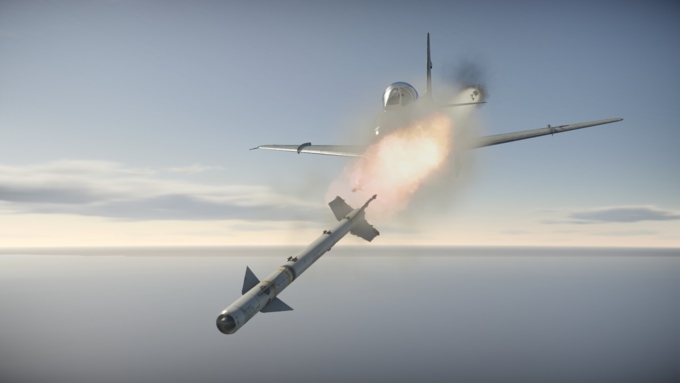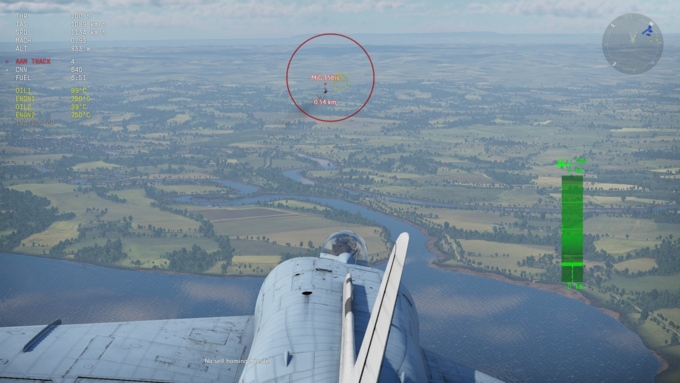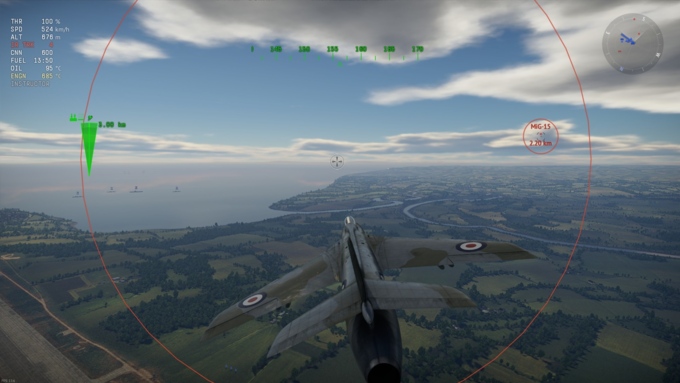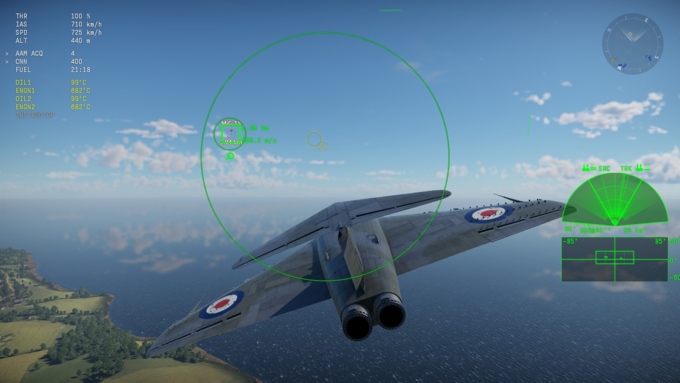Infrared (IR) homing missiles, also known as heat-seeking missiles, or heat-seekers, are the most widespread type of air-to-air missile in War Thunder. Infrared homing missiles have what is known as an IR seeker mounted in the nose of the missile. The IR seeker is capable of detecting the infrared light emitted by the target; and when the missile is launched the IR seeker tracks the source of infrared light and steers the missile towards it. These missiles are commonly called “heat-seekers”, as things which are hot emit large amounts of infrared light, so the missile is effectively looking for hot things to lock on to. Infrared homing missiles will lock on to any suitably strong infrared light source; this includes friendly aircraft (RB and SB) and the sun.
Using Infrared Missiles
Firing infrared homing missiles in-game is a little more complicated than firing other types of weaponry. You must first turn on the IR seeker. Once the seeker is turned on you will see a circle (green by default) appear on your screen, the missile seeker is now being cooled down to improve the performance; the length of time required for the seeker to cool down can vary between missiles, but it is generally a second.
Once the seeker has cooled down it will become active, and the green circle will begin to flash; this will be accompanied by a “growling” noise to let you know the missile is active. You must now maneuver your aircraft to place the circle over the target you wish to lock on to. Some aircraft are equipped with a Head-Mounted Display (HMD), which will allow the lock of the missile to also be controlled by the free-look direction, rather than having to maneuver the nose of the aircraft towards the target.
The seeker on each missile has a maximum range at which it can lock on to a target; you will need to be within that range to get a lock. Most missiles will also require you to be in the rear aspect (behind) of your target so that the missile can lock onto the target’s engine exhaust.
Once a lock is achieved, the green circle will turn solid red and the growling noise will change in tone, indicating a lock. Once a lock is achieved you can fire the missile, after this point the missile requires no further input and will guide itself to the target.
Once the missile is fired there is no guarantee it will hit the target. Early missiles cannot turn very tightly (about 5G), so it is possible for the enemy player to dodge the missile.
Important notes:
- If your missile locks onto the wrong target before you launch it, you can turn the seeker off then back on again to reset it and force it to find a new target (this is mainly a problem for missiles with uncaged seekers, where you cannot easily move the seeker ring off the target).
- If you are in the cockpit view, there are no lock circles visible; you must rely purely on the growling tone to know when the missile seeker is active and locked.
- Each missile has a maximum amount of time the seeker can be powered up for before launch. If this time is exceeded the seeker will turn off and have to be turned back on again manually.
- Just because you have achieved a missile lock does not mean it is a good idea to fire the missile; many missiles can lock onto a target which is outside of their effective range (although within their maximum range). Make sure you have closed to a good firing range. In addition, firing while yourself, or the enemy plane, is mid-manoeuvre, makes it much easier for the missile to be dodged.
- Once a missile is fired, it can lose its lock on the enemy aircraft and lock on to something else; if a friendly flies in front of your missile be prepared for the missile to start chasing them instead. Likewise, if the sun is in the background of your target, expect the missile to fly towards the sun (after all the missile is looking for infrared light, and the sun puts out way more of that than the enemy plane does).
- If there is more than one target in front of the missile’s seeker, the seeker may get confused and the missile will likely fly off course and miss.
Caged vs uncaged missile seekers
Most early infrared homing missiles have what is known as a caged IR seeker prior to being launched, this means the seeker is locked facing directly forwards. This is the mode described in the section above; in-game you will see a small circle, which you have to position over a target to get a lock, then hold over the target until you fire the missile.
Some more advanced missiles are capable of “uncaging” their seeker once a target has been locked. This means that once the seeker has locked onto a target it is free to move. In practice this means that once you have locked on to a target with one of these missiles you no longer have to manually keep the missile’s seeker over the target to maintain a lock prior to launch, the missile will maintain its own lock and you can (within reason) maneuver your aircraft before firing the missile.
In-game, when the seekers of these missiles are turned on, you will see the normal missile seeker ring, but there will also be a larger ring present around the missile seeker ring. To lock on you still need to position the smaller ring over the target, but once a lock is achieved you only need to keep the target within the larger ring to maintain a lock.
Uncaged seekers are a major advantage as they make maintaining a lock prior to launch much easier. They also allow you to “lead” the missiles like you would your guns, making them more likely to hit turning opponents.
Slaving the seeker to an aircraft tracking radar
Aircraft which have tracking radars are able to slave the missile’s IR seeker to their radar system. This means that when a target is being tracked by the radar and the missile seeker is turned on, instead of the seeker pointing directly forwards it will receive data from the radar and point at the target the radar is locked on to.
Rotorcraft with a gunner seat or ATGM tracking camera may also guide their seeker manually by hopping in the gunner seat or using the tracking camera, however it is not possible to fire the missile until the player switches back to pilot mode. It is important that the crosshair is pointing at the enemy aircraft and locked upon switching back to the pilot seat otherwise the seeker head will reset.
The benefits of slaving the IR seeker to the tracking radar are essentially the same as having an uncaged sensor; making achieving and maintaining a lock easier, as well as allowing you to “lead” the missile in some situations. A disadvantage is that opponents with RWR will become alerted by the locking of the radar, thus alerting them to the presence of a potential missile.
All-Aspect Seekers
Most infrared homing missiles in-game are what are known as “rear-aspect” missiles, which require you to be in the rear-aspect of your target (behind the target) in order for the missile to lock on. This is because early IR seekers were only sensitive enough to lock on to very hot targets, such as the exhaust of a jet engine. There are however some more advanced missiles in-game which are known as “all-aspect” missiles, these missiles have more sensitive IR seekers and better tracking systems which are able to detect other heat sources, such as those emitted from the body of the aircraft or from the plume of afterburner flame expanding out from the aircraft, allowing the missile to lock on to and engage a target from any direction. These missiles are a major upgrade from other infrared homing missiles, they allow you to attack a target from any direction and are much harder to dodge.
Countermeasures
There are general techniques pilots can employ to dodge missiles (covered in a later section), however, in addition, some vehicles also have systems dedicated to defeating infrared homing missiles. These systems fall into two categories: flares and IRCM systems.
Flares
The most basic countermeasure to infrared homing missiles is the use of flares. Flares are a type of pyrotechnic which can be fired (usually in bursts) from the target aircraft when the pilot believes a heat-seeking missile has been fired at them. The flare burns extremely hot and produces a large amount of infrared light; this will often trick the IR seeker of the missile into locking on to the flares instead of the target aircraft. More modern missiles with more advanced IR seekers are less vulnerable to flares.
If a target you are locking onto deploys flares, you will often see the seeker ring move over to the flares instead of the target. If the target deploys flares after a missile has been fired, then the missile will often switch course and fly towards the flares. Some modern missiles in-game are not affected as much by flares, however, this doesn’t mean the missile is completely invulnerable to countermeasures.
Infrared Counter Measures (IRCM) systems
A more advanced countermeasure to infrared-guided missiles are Infrared Counter Measures (IRCM) systems, these systems are effectively jammers for infrared missiles. There are two techniques used by these systems: older systems would have a powerful infrared light source, which was then flickered on and off; this would disrupt the missile’s guidance system and cause it to fly off course. More modern systems detect the missile and shine a laser directly at it, blinding the IR seeker.



